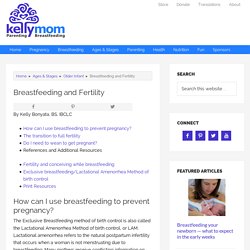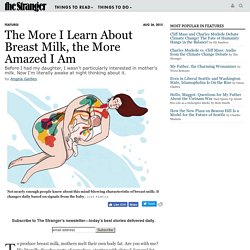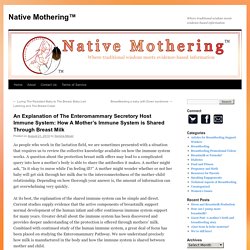

Breastfeeding and Fertility. By Kelly Bonyata, BS, IBCLC How can I use breastfeeding to prevent pregnancy?

The Exclusive Breastfeeding method of birth control is also called the Lactational Amenorrhea Method of birth control, or LAM. Lactational amenorrhea refers to the natural postpartum infertility that occurs when a woman is not menstruating due to breastfeeding. Many mothers receive conflicting information on the subject of breastfeeding and fertility. Myth #1 – Breastfeeding cannot be relied upon to prevent pregnancy. Myth #2 – Any amount of breastfeeding will prevent pregnancy, regardless of the frequency of breastfeeding or whether mom’s period has returned. Exclusive breastfeeding has in fact been shown to be an excellent form of birth control, but there are certain criteria that must be met for breastfeeding to be used effectively. Exclusive breastfeeding (by itself) is 98-99.5% effective in preventing pregnancy as long as all of the following conditions are met: If you practice ecological breastfeeding: The Alpha Parent: Timeline of a Breastfed Baby.
All babies reach milestones on their own developmental timeline.

A multitude of factors influence the rate of each baby’s individual growth such as genetics, form of delivery, gestation at delivery, medical issues, effectiveness of the placenta prior to delivery, and so on. However there is a persistent and understandable demand from first-time mothers for information on what is considered ‘the norm’. This is particularly so with breastfeeding, as understanding breastmilk intake is more complex than looking at the oz mark on a bottle. This is a topic rife with large-scale confusion, especially as breastfeeding mothers are in the minority and can often find themselves, and their health workers, comparing their baby with formula-fed babies. Breastfed babies are not the same as formula fed babies. What follows is a timeline detailing the journey of the average breastfed baby. At Birth: During your baby's first 24 hours, he might wet his nappy only once or twice (Fredregill 2004).
Day 3: The More I Learn About Breast Milk, the More Amazed I Am. Not nearly enough people know about this mind-blowing characteristic of breast milk: It changes daily based on signals from the baby. lily padula To produce breast milk, mothers melt their own body fat.

Are you with me? We literally dissolve parts of ourselves, starting with gluteal-femoral fat, aka our butts, and turn it into liquid to feed our babies. Before and after giving birth to my daughter 10 months ago, I was inundated with urgent directives from well-meaning, very insistent health practitioners, parenting book authors, mommy bloggers, journalists, and opinionated strangers that "breast is best. " The message was clear: In order to be a good mom, I had to breast-feed. But breast-feeding is more than being a good mom. Breast-feeding leads to better overall health outcomes for children, which is why the World Health Organization and the American Academy of Pediatrics recommend that babies be exclusively breast-fed for a minimum of six months.
I find this thrilling. An Explanation of The Enteromammary Secretory Host Immune System: How A Mother's Immune System is Shared Through Breast Milk - Native Mothering™Native Mothering™ As people who work in the lactation field, we are sometimes presented with a situation that requires us to review the collective knowledge available on how the immune system works.

A question about the protection breast milk offers may lead to a complicated query into how a mother’s body is able to share the antibodies it makes. A mother might ask, “Is it okay to nurse while I’m feeling ill?” A mother might wonder whether or not her baby will get sick through her milk due to the interconnectedness of the mother-child relationship. Depending on how thorough your answer is, the amount of information can get overwhelming very quickly. At its best, the explanation of the shared immune system can be simple and direct. Why Is the Maternal Immune System Shared? How is the Immune System Shared? A pathogen is “a specific causative agent (as a bacterium or virus) of a disease.”
What If There is Exposure to Grave Illness? What Area In the Body Does the Information About Infection Come From?